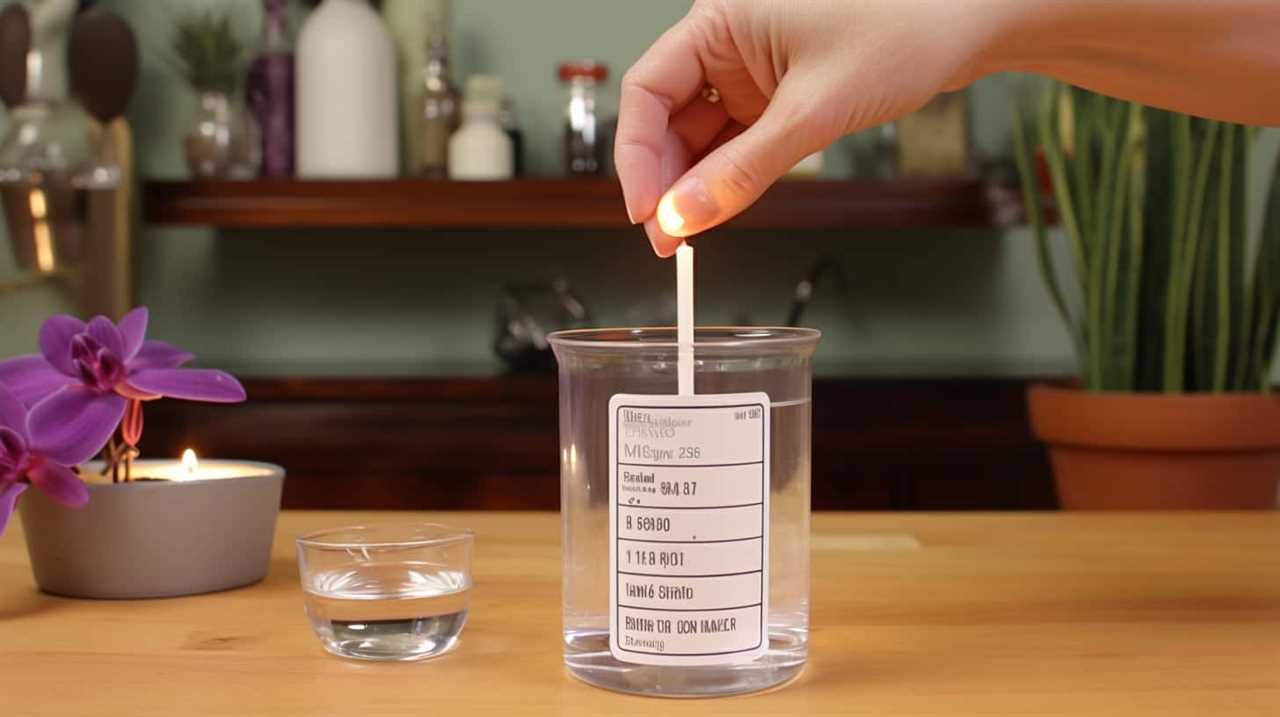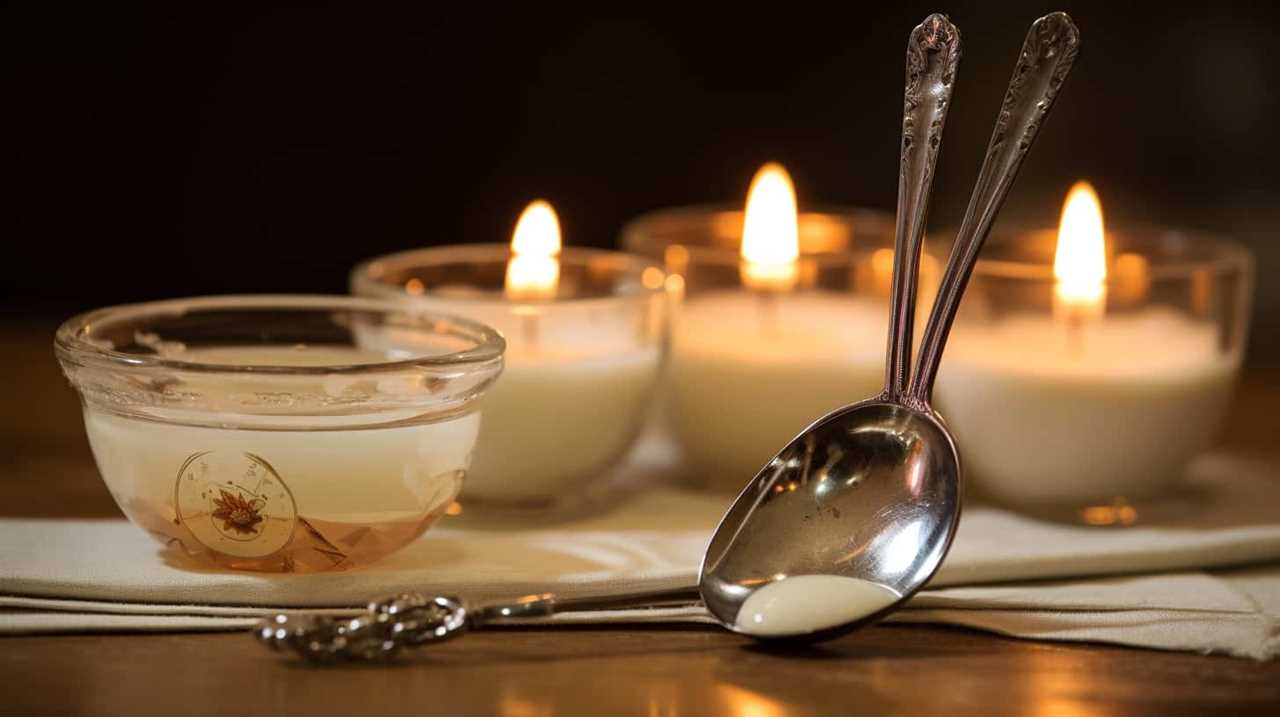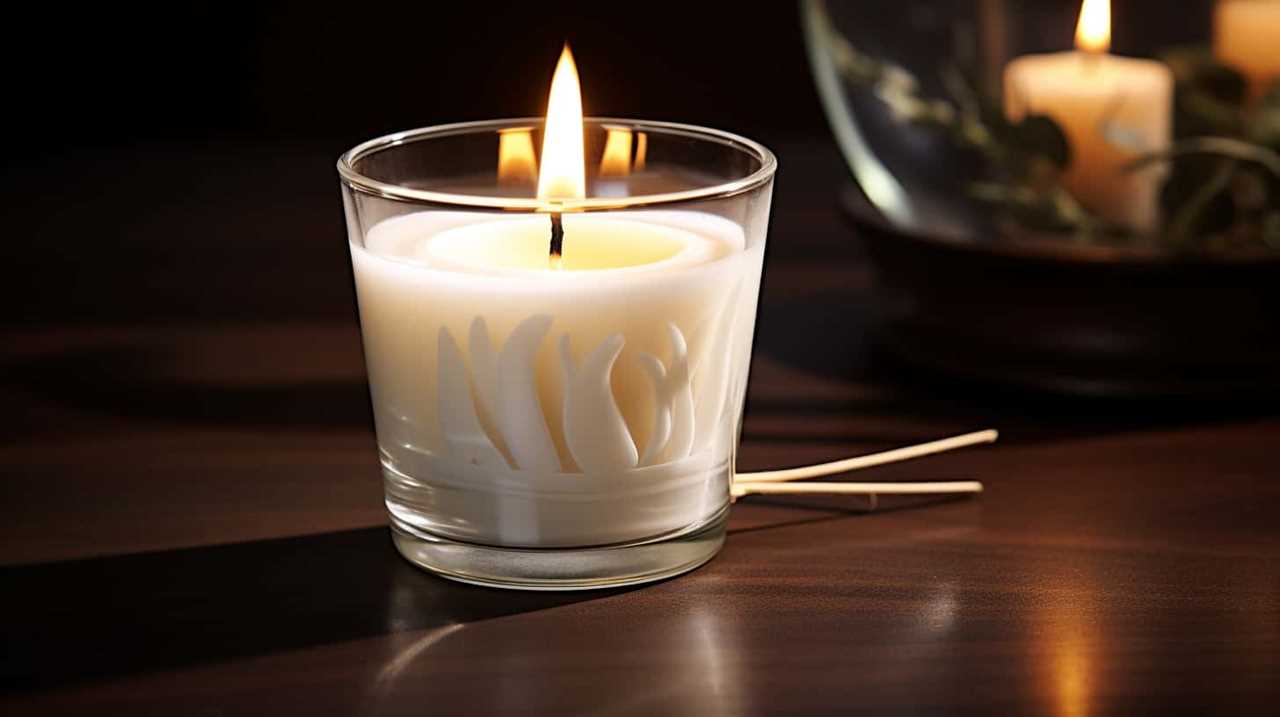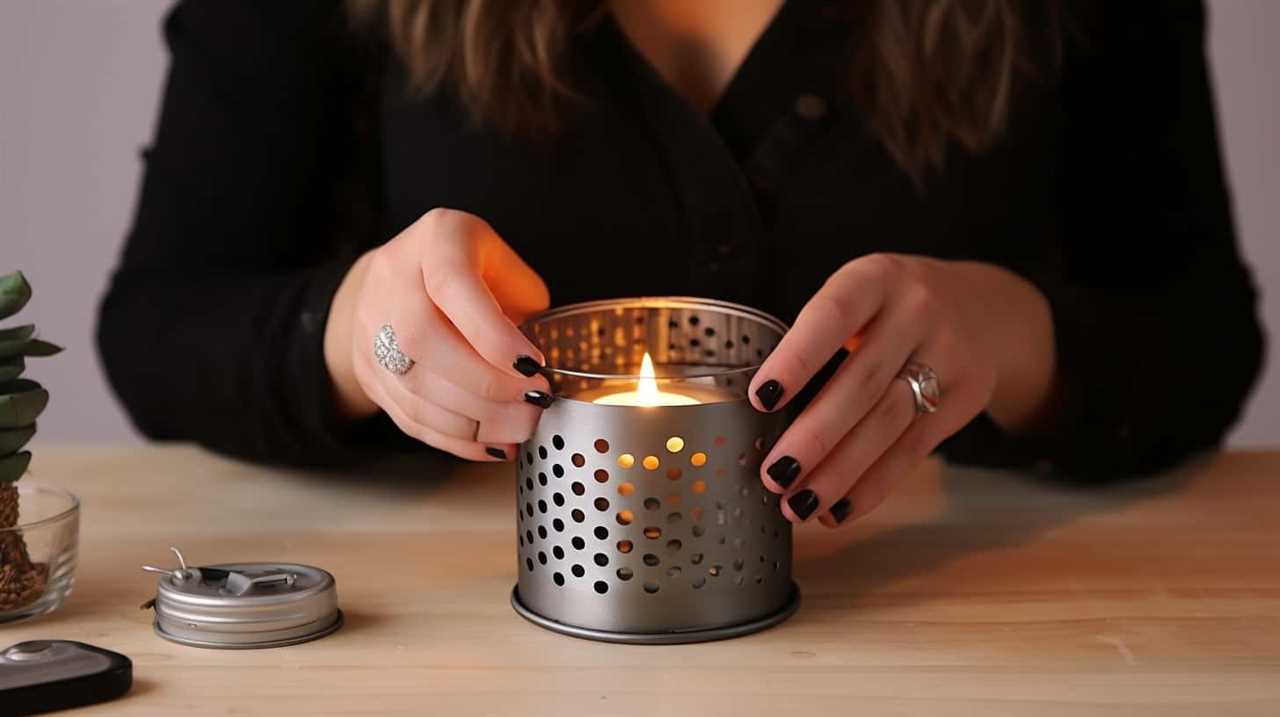Hello, everyone! Did you know that candle wax stains on walls are a common issue in households? But fear not, we have the ultimate guide to help you remove those stubborn stains with ease, just like a pro!
In this quick and easy tutorial, we’ll walk you through the step-by-step process, so you can master the art of removing candle wax stains from your walls. No need to fret, we’ll have those walls looking spick and span in no time.
So, let’s dive right in and learn how to tackle this challenge head-on. Get ready to say goodbye to candle wax stains and hello to spotless walls!
Let’s get started!

Key Takeaways
- Gathering necessary supplies, including alternative eco-friendly options, for removing candle wax stains
- Scraping off excess wax using a plastic card and using a heat gun
- Applying vinegar to dissolve remaining wax residue
- Using a hairdryer on a low heat setting to melt wax and wiping it away with a clean cloth
Gather Necessary Supplies
We will need a few essential supplies to effectively remove the candle wax stain from the wall.
When it comes to removing wax from walls, there are alternative supplies that can be used, which are also eco-friendly options. One such alternative is using a hairdryer. By applying heat to the wax stain and gently scraping it off with a plastic card, such as a credit card, you can effectively remove the wax without causing damage to the wall.
Another eco-friendly option is using a mixture of water and vinegar. Simply dampen a cloth with the mixture and gently rub the wax stain until it lifts off.
These alternative supplies provide a safe and environmentally friendly way to remove candle wax stains from your walls.

Scrape off Excess Wax
To remove the candle wax stain from the wall, it’s necessary to scrape off any excess wax using a plastic card or similar tool. This step is crucial in preparing the surface for further cleaning.
Here are the steps to scrape off excess wax effectively:
- Start by gently scraping the surface of the wax using the plastic card. Be careful not to damage the wall.
- Apply moderate pressure and scrape in a downward motion to lift off as much wax as possible.
- If the wax is particularly stubborn, you can use a heat gun on low setting to soften it before scraping.
- Be cautious when using a heat gun to avoid overheating and damaging the wall.
- Once most of the wax has been scraped off, you can apply vinegar to the remaining residue to further dissolve and remove it.
Use a Hairdryer to Melt the Wax
To effectively melt the wax, use a hairdryer on a low heat setting. Before starting the melting technique, it’s important to take preventive measures to protect the surrounding area. Place a towel or a cloth beneath the wax stain to catch any drips or residue. Additionally, you can cover adjacent surfaces with newspaper or plastic to prevent any accidental damage.
Once you’ve set up the necessary precautions, plug in the hairdryer and turn it on to the lowest heat setting. Hold the hairdryer about 6 to 8 inches away from the wax stain and move it in a circular motion. The heat from the hairdryer will gradually melt the wax, allowing it to be wiped away easily with a clean cloth.

Be patient and avoid using high heat, as it can cause damage to the wall.
Blot the Melted Wax With Paper Towels
Now that we’ve successfully melted the candle wax using a hairdryer, it’s time to move on to the next step: blotting the melted wax with paper towels. This method helps to absorb the melted wax and remove it from the wall surface.
However, it’s important to note that there are other methods available for removing candle wax stains, and it might be worth exploring those as well.
Additionally, we should also discuss some preventive measures to avoid future wax stains on the wall.

Other Removal Methods
After melting the candle wax, we can easily remove it from the wall by blotting it with paper towels. However, if this method doesn’t fully remove the wax stain, there are alternative cleaning methods that can be used. Here are some safe removal techniques to consider:
- Use a hairdryer: Set the hairdryer on a low heat setting and aim it at the wax stain. As the wax melts, use a paper towel to blot it away.
- Apply ice: Place an ice pack or a bag of frozen vegetables on the wax stain. Once the wax hardens, gently scrape it off using a plastic card or your fingernail.
- Use a cleaning solution: Mix equal parts water and vinegar or rubbing alcohol. Dampen a cloth with the solution and gently rub the wax stain until it lifts away.
- Try a commercial wax remover: Look for a wax remover specifically designed for walls. Follow the instructions on the product for safe and effective removal.
- Seek professional help: If all else fails, consider hiring a professional cleaner who specializes in removing stubborn stains from walls.
Preventing Future Wax Stains?
To prevent future wax stains on the wall, we can continue the process by blotting the melted wax with paper towels. This step is essential in preventing wax buildup and maintaining a clean wall surface. By immediately blotting the melted wax with paper towels, we can effectively remove any excess wax and minimize the chances of staining.
Additionally, it’s advisable to use protective barriers such as a heat-resistant mat or tray underneath candles to catch any drips or spills. These barriers will help prevent the wax from coming into direct contact with the wall, reducing the risk of stains.
Taking these preventive measures will ensure that your walls remain wax-free and pristine.

Now, let’s move on to the next step: applying rubbing alcohol to the stain.
Apply Rubbing Alcohol to the Stain
When it comes to removing candle wax stains from walls, applying rubbing alcohol can be an effective method. Rubbing alcohol acts as a solvent, breaking down the wax and making it easier to remove.
However, it’s important to note that there are alternative stain removal methods available, such as using a hairdryer or freezing the wax with ice.
Additionally, when using rubbing alcohol, it’s essential to take precautions such as testing it on a small, inconspicuous area first and ensuring proper ventilation in the room.

Rubbing Alcohol Effectiveness
We found that by applying rubbing alcohol to the candle wax stain on the wall, we were able to effectively remove it. Rubbing alcohol is a highly effective solution for removing candle wax stains, as it helps to dissolve the wax and lift it from the surface of the wall.
Here are some key points to consider when using rubbing alcohol for this purpose:
- Rubbing alcohol is readily available and affordable, making it a convenient choice for cleaning wax off walls.
- It’s important to test a small, inconspicuous area of the wall before applying rubbing alcohol to ensure that it doesn’t cause any damage or discoloration.
- If rubbing alcohol isn’t available, there are alternative methods such as using a hairdryer to melt the wax and then blotting it with a clean cloth.
- When cleaning wax off fabric, it’s important to place a clean cloth or paper towel underneath the stained area to prevent the wax from transferring to other parts of the fabric.
- Always blot the stain gently, rather than rubbing it, to avoid spreading the wax further or damaging the wall surface.
Alternative Stain Removal Methods
After testing the effectiveness of rubbing alcohol in removing candle wax stains from walls, we discovered an alternative stain removal method that involves applying rubbing alcohol directly to the stain. This method is one of the alternative cleaning techniques that can be used for natural stain removal.
To apply rubbing alcohol to the stain, start by pouring a small amount onto a clean cloth or cotton ball. Gently dab the cloth or cotton ball onto the stained area, being careful not to rub too vigorously. Allow the rubbing alcohol to sit on the stain for a few minutes to allow it to penetrate and loosen the wax.

Then, use a clean cloth to wipe away the stain, repeating the process if necessary. This alternative method can be effective in removing candle wax stains from walls, providing a natural and efficient stain removal solution.
Precautions When Using Rubbing Alcohol
To ensure safe and effective use of rubbing alcohol when applying it to the stain, it’s important to take certain precautions. Here are some key safety measures to keep in mind:
- Always work in a well-ventilated area to avoid inhaling fumes.
- Wear protective gloves to prevent skin irritation or allergic reactions.
- Keep rubbing alcohol away from open flames or sparks, as it’s highly flammable.
- Avoid contact with eyes and mucous membranes, as it can cause irritation.
- Store rubbing alcohol in a cool, dry place, away from heat and sunlight.
By following these precautions, you can safely use rubbing alcohol to remove the candle wax stain from your wall.
Now, let’s move on to the next step: gently scrubbing the area with a sponge.

Gently Scrub the Area With a Sponge
To remove a candle wax stain from a wall, begin by gently scrubbing the affected area with a sponge. This step is crucial in ensuring that the wax is properly loosened and removed without damaging the wall’s surface. It’s important to use a sponge with a soft texture to prevent any scratches or marks on the wall.
In order to provide you with a comprehensive guide, here is a table outlining some preventive measures and gentle cleaning techniques that can be used to maintain the cleanliness of your walls:
| Preventive Measures | Gentle Cleaning Techniques |
|---|---|
| Use a candle holder or tray to catch any dripping wax | Place a paper towel or old cloth underneath the candle to catch any potential drips |
| Trim the candle wick to prevent excessive dripping | Use a hairdryer on a low heat setting to warm the wax and make it easier to remove |
| Avoid placing candles close to walls or other surfaces | Gently scrape off any excess wax using a plastic card or spatula |
Make a Homemade Cleaning Solution
To efficiently remove candle wax stains from a wall, we can create a homemade cleaning solution. There are several homemade cleaning alternatives and natural cleaning solutions that can effectively tackle candle wax stains. Here are some options to consider:
- Vinegar solution: Mix equal parts white vinegar and water in a spray bottle.
- Baking soda paste: Create a paste by mixing baking soda with a small amount of water.
- Lemon juice: Squeeze fresh lemon juice onto the stain.
- Rubbing alcohol: Dampen a cloth with rubbing alcohol and gently rub the stain.
- Dish soap solution: Mix a few drops of dish soap with warm water.
These homemade cleaning solutions aren’t only effective but also safe to use on walls.

Now, let’s move on to the next step and learn how to dab the stain with the cleaning solution.
Dab the Stain With the Cleaning Solution
We can now apply the homemade cleaning solution to the candle wax stain on the wall. This step is crucial in removing the stubborn wax residue and restoring the wall’s pristine appearance. Before we proceed, let’s compare the effectiveness of rubbing alcohol and the homemade cleaning solution.
| Rubbing Alcohol | Homemade Cleaning Solution | |
|---|---|---|
| Effectiveness | Effective in dissolving wax. | Effective in breaking down wax and removing stains. |
| Availability | Easily accessible in stores. | Can be made using household ingredients. |
| Safety | Flammable, strong fumes. | Non-toxic, safe to use. |
Now, let’s move on to the next decision – whether to use a hairdryer or scrape off excess wax. Here’s a comparison:
| Hairdryer | Scraping Off Excess Wax | |
|---|---|---|
| Effectiveness | Melts wax, making it easier to remove. | Directly removes excess wax. |
| Risk of Damage | May cause heat damage if not used properly. | May leave scratches on the wall. |
Use a Toothbrush to Scrub the Stain
How can we effectively scrub the candle wax stain off the wall using a toothbrush?

The toothbrush is a versatile tool that can help remove stubborn stains from various surfaces, including walls. Here are some tips on using a toothbrush to effectively scrub the candle wax stain off the wall:
- Choose a toothbrush with medium or firm bristles for better scrubbing effectiveness.
- Wet the toothbrush with warm water to soften the bristles and make them more effective in removing the wax stain.
- Gently scrub the stained area using circular motions, applying slight pressure.
- Rinse the toothbrush frequently to remove the loosened wax and prevent smearing.
- For larger or more stubborn stains, consider using alternative scrubbing tools such as a soft-bristle scrub brush or an old toothbrush with firmer bristles.
Rinse the Wall With Clean Water
After scrubbing the candle wax stain off the wall with a toothbrush, we need to rinse the wall with clean water. Rinsing is an important step in the process of removing candle wax stains, as it helps to remove any residual wax and cleaning solution from the wall.
To rinse the wall, fill a bucket with clean water and use a sponge or cloth to gently wipe down the area where the stain was. Make sure to wring out the sponge or cloth well, as you don’t want to oversaturate the wall. Continue wiping until all traces of the cleaning solution and wax are gone.
If necessary, you can also use a spray bottle filled with clean water to mist the wall and then wipe it down. Remember, it’s important to use safe cleaning techniques and avoid harsh chemicals when removing candle wax stains.

Dry the Wall With a Clean Cloth
Now that we’ve rinsed the wall with clean water, the next step is to dry it thoroughly using a clean cloth. Drying the wall is crucial to prevent any remaining moisture from seeping into the surface and causing further damage or discoloration.
By ensuring that the wall is completely dry, we can effectively remove stubborn stains and restore the wall to its original condition.
Additionally, if the candle wax stain persists, we can explore alternative cleaning methods to tackle the issue.
Removing Stubborn Stains
To remove stubborn candle wax stains from the wall, we can start by drying the wall with a clean cloth. Once the wall is dry, we can proceed with removing the stubborn stains using alternative cleaning methods that are safe for the wall’s surface.

Here are five effective ways to tackle stubborn candle wax stains on walls:
- Use a hairdryer: Set the hairdryer on low heat and hold it a few inches away from the wax stain. Gently heat the wax until it softens, then wipe it away with a clean cloth.
- Apply rubbing alcohol: Dampen a cloth with rubbing alcohol and gently rub the wax stain in circular motions until it lifts off the wall.
- Use a mixture of dish soap and warm water: Create a solution by mixing dish soap with warm water. Dip a cloth into the solution and gently scrub the wax stain until it disappears.
- Try vinegar: Soak a cloth in white vinegar and apply it to the wax stain. Let it sit for a few minutes before wiping the stain away.
- Utilize a commercial adhesive remover: Follow the instructions on the adhesive remover product carefully, applying it to the wax stain and gently wiping it away.
Preventing Wall Discoloration
Let’s quickly dry the wall with a clean cloth to prevent any potential wall discoloration. Drying the wall with a clean cloth will ensure that no water or residue is left behind, preventing any potential damage to the wall’s surface. After removing the candle wax stain, it’s important to thoroughly dry the wall to avoid any moisture seeping into the paint or causing paint peeling. Additionally, it’s recommended to use protective coverings, such as plastic sheets or drop cloths, when dealing with candle wax stains to further safeguard the wall from any accidental spills or splatters. By taking these preventive measures, you can maintain the integrity of your walls and prevent any unsightly discoloration.
Now, let’s move on to explore alternative cleaning methods.
Alternative Cleaning Methods
One effective way to remove candle wax stains from walls is by using a clean cloth to dry the affected area. This method is an alternative to using traditional cleaning products and offers a more natural cleaning option.

Here are five alternative cleaning methods to consider:
- Vinegar: Dampen the cloth with vinegar and gently rub the wax stain until it disappears.
- Baking soda: Make a paste using baking soda and water, then apply it to the stain and scrub gently with the cloth.
- Lemon juice: Squeeze lemon juice onto the cloth and rub it on the wax stain. The acidity of the lemon helps break down the wax.
- Ice: Place an ice pack or ice cubes in a plastic bag and hold it against the wax stain until the wax hardens. Then, scrape off the hardened wax with a plastic card.
- Hairdryer: Set the hairdryer to low heat and blow hot air onto the wax stain. As the wax melts, use the cloth to wipe it away.
Apply a Stain Remover if Necessary
If the candle wax stain is stubborn and not easily removed with the previous methods, we can apply a stain remover to effectively tackle the problem. Sometimes, despite our best efforts to apply heat or try other removal techniques, candle wax stains can still linger on the wall.
In such cases, using a stain remover can be a game-changer. Look for a stain remover specifically designed for removing wax stains, as they often contain ingredients that break down and dissolve the wax residue. Before applying the stain remover, always read the manufacturer’s instructions and test it on a small, inconspicuous area of the wall to ensure it doesn’t cause any damage.
Once the stain remover has been applied, gently scrub the affected area with a soft cloth or sponge, following the product’s recommendations. This will help to remove any remaining traces of the wax stain and restore the wall to its former glory. Finally, assess the wall for any remaining stains and move on to the next step if necessary.

Assess the Wall for Any Remaining Stains
Now that we’ve applied a stain remover, it’s important to assess the wall for any remaining stains. Stubborn wax residue may still be present, especially if the stain wasn’t completely removed during the previous steps. By carefully examining the wall, we can determine if any further cleaning is necessary.
Additionally, we should consider implementing safe cleaning methods to avoid damaging the wall’s surface.
Lastly, it may be helpful to explore preventive measures to avoid future candle wax stains on the wall.
Stubborn Wax Residue
We carefully inspect the wall to identify any remaining stains caused by the stubborn wax residue. It’s important to thoroughly assess the wall to ensure that no traces of wax are left behind.

Here are some alternative cleaning methods that can be used to tackle stubborn wax residue on walls:
- Rubbing alcohol: Dampen a cloth with rubbing alcohol and gently rub the stained area in circular motions.
- Vinegar solution: Mix equal parts vinegar and water, then apply the solution to the stain using a cloth or sponge.
- Warm water and dish soap: Create a soapy mixture and use a cloth to scrub the stain until it’s lifted.
- Heat method: Place a clean cloth over the wax residue and use a warm iron to melt the wax, then wipe it away.
- Baking soda paste: Make a paste using baking soda and water, apply it to the stain, and scrub gently with a cloth.
Safe Cleaning Methods
After inspecting the wall for any remaining stains, we proceed to assess the effectiveness of various safe cleaning methods to remove stubborn wax residue.
When it comes to preventing wax drips on walls, it’s important to use protective measures such as placing a heat-resistant surface, like a tray or a dish, under the lit candle. This can help catch any drips and prevent them from staining the wall.
As for cleaning methods, we recommend using natural cleaning solutions that are safe for both the wall and the environment.

One effective method is to mix equal parts of white vinegar and water in a spray bottle. Spray the solution onto the stained area and let it sit for a few minutes. Then, using a clean cloth or sponge, gently scrub the stain in a circular motion until the wax residue is lifted. Repeat if necessary.
Another natural option is to use baking soda. Make a paste by mixing baking soda with a small amount of water. Apply the paste to the stain and let it dry completely. Once dry, gently scrub the paste off the wall using a soft brush or cloth.
These safe cleaning methods can effectively remove stubborn wax residue while ensuring the integrity of your wall.
Prevent Future Stains?
To prevent future stains, it’s important to assess the wall for any remaining wax residue. This step is crucial in ensuring that your efforts to remove the current stain won’t be in vain. By thoroughly inspecting the wall, you can identify any missed spots or hidden wax drips that may lead to future stains.

Here are some key areas to focus on during the assessment:
- Check the surface of the wall for any visible wax residue.
- Inspect corners and crevices where wax may have accumulated.
- Pay attention to areas near candle holders or shelves where spills are more likely to occur.
- Look for any discoloration or irregularities in the paint or wallpaper.
- Consider using a flashlight to examine the wall more closely, especially if the lighting is poor.
Take Preventive Measures to Avoid Future Stains
To prevent future candle wax stains on your walls, regularly inspect and clean your candle holders. This is an essential step in maintaining a clean and stain-free environment.
By inspecting your candle holders, you can identify any potential issues such as cracked or chipped holders that may cause wax to spill onto your walls.
Additionally, cleaning your candle holders regularly will remove any residue or build-up that could contribute to future stains. When cleaning your holders, it’s important to use effective cleaning products that are specifically designed for candle wax removal. These products are formulated to dissolve and remove wax without damaging the surface of your holders.

Frequently Asked Questions
What Should I Use to Scrape off the Excess Wax From the Wall?
To scrape off excess wax from the wall, we can use a variety of scraping tools such as a plastic scraper or a credit card. Alternatively, you can try using heat or freezing methods to make the wax brittle and easier to remove.
Can I Use a Different Method to Melt the Wax if I Don’t Have a Hairdryer?
If we don’t have a hairdryer, there are alternative methods to melt the wax off the wall. We can try using a hot iron or a heat gun, both of which can be found in most households.
How Long Should I Blot the Melted Wax With Paper Towels?
We need to determine the appropriate drying time for the blotting technique. It’s important to ensure that the melted wax is completely absorbed by the paper towels before moving on to the next step.
What Ingredients Can I Use to Make a Homemade Cleaning Solution?
When it comes to natural cleaning solutions, we’ve got you covered. Homemade cleaning products offer a multitude of benefits, from being environmentally friendly to saving you money. Let’s explore the ingredients to create your own effective cleaning solution.

Are There Any Specific Preventive Measures I Can Take to Avoid Future Candle Wax Stains on the Wall?
Preventive measures can save you from future candle wax stains on the wall. Here are some tips and tricks: place a protective barrier like a tray or foil under the candle, avoid placing candles too close to the wall, and consider using flameless candles.
Conclusion
In conclusion, removing candle wax stains from a wall can be easily accomplished with a few simple steps.
By gathering the necessary supplies and following the directions provided, you can effectively eliminate the stain and restore the wall’s appearance.
Remember to investigate the truth of any theories or tips you come across to ensure the most effective results.

With a detail-oriented and knowledgeable approach, you can quickly and successfully remove candle wax stains from your walls.









